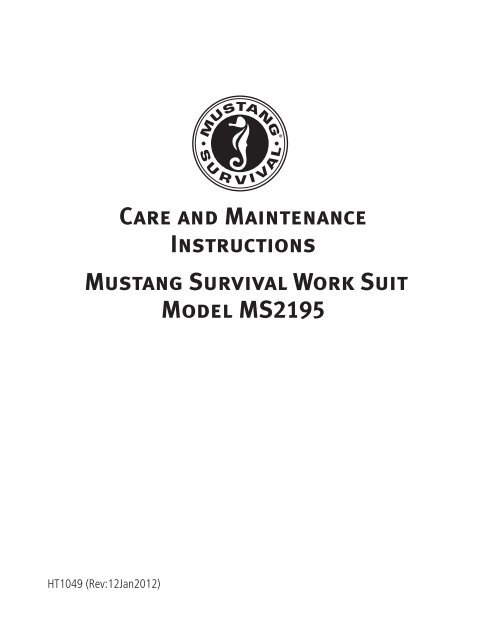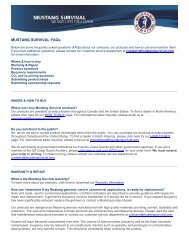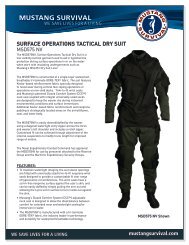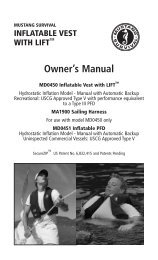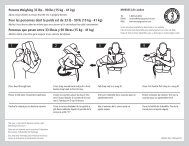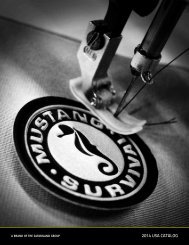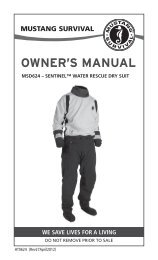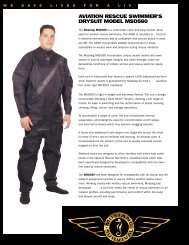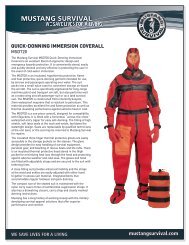Care and Maintenance Instructions Mustang Survival Work Suit ...
Care and Maintenance Instructions Mustang Survival Work Suit ...
Care and Maintenance Instructions Mustang Survival Work Suit ...
You also want an ePaper? Increase the reach of your titles
YUMPU automatically turns print PDFs into web optimized ePapers that Google loves.
<strong>Care</strong> <strong>and</strong> <strong>Maintenance</strong><strong>Instructions</strong><strong>Mustang</strong> <strong>Survival</strong> <strong>Work</strong> <strong>Suit</strong>Model MS2195HT1049 (Rev:12Jan2012)
<strong>Care</strong> <strong>and</strong> <strong>Maintenance</strong> <strong>Instructions</strong><strong>Mustang</strong> <strong>Survival</strong> <strong>Work</strong> <strong>Suit</strong> Model MS21951Table of Contents1.0 Introduction 21.1 General 21.2 Intended Use 22.0 Description 22.1 General 22.2 Flotation 32.3 Closures 43.0 <strong>Maintenance</strong> 43.1 Introduction 43.2 Inspection 43.3 Servicing 53.4 Storage 73.5 Failure Reporting <strong>and</strong> Repair 8
21.0 Introduction1.1 GeneralThe <strong>Mustang</strong> <strong>Work</strong> <strong>Suit</strong> Model MS2195 is an item of primarysurvival equipment, <strong>and</strong> as such, every precaution should betaken to assure its proper storage, maintenance, <strong>and</strong>h<strong>and</strong>ling.The life of an individual adrift at sea may well depend on thecondition of his suit, security of its closures, <strong>and</strong> his knowledgein the use of the hypothermia protective features provided.1.2 Intended UseThis suit is intended to be worn while working upon or near thewater. It cannot save your life if it is not being worn, or isworn improperly.2.0 Description2.1 GeneralThe suit is designed to insulate the wearer from exposure towind <strong>and</strong> cold water. It is also designed to provide a level of flotationwhich is greater than that specified for Coast Guardapproved Personal Flotation Devices or Buoyancy Aids. Thesuit provides some protection against onset of hypothermiaupon immersion in cold water. The hypothermia protectioncharacteristics are significantly enhanced with proper use <strong>and</strong>adjustment of the closures provided.
The suit is Canadian Coast Guard Approved as an Anti-Exposure<strong>Work</strong> <strong>Suit</strong>, <strong>and</strong> as a Type I Personal Flotation Device. The suitconsists of a durable water resistant orange coloured nylon fabricouter shell, a buoyant PVC closed cell foam interliner, <strong>and</strong> alightweight nylon fabric lining. The PVC interliner is fixed to thelining of the suit to prevent shifting <strong>and</strong> bunching of the buoyantmaterial.A high collar, wide storm flap, <strong>and</strong> adjustable neoprene cuffsminimize exposure of the wearer to wind, cold water, <strong>and</strong> adverseconditions.An insulated hood is provided, attached to the suit at the baseof the collar.Pockets are provided for storage of equipment <strong>and</strong> personalitems.Zippered gussets at the base of the legs assist in donning <strong>and</strong>doffing over footwear.The suit incorporates an inflatable head pillow, which provideswearer comfort <strong>and</strong> supplemental buoyancy while in the water.The head pillow is inflated manually by the wearer by blowing intothe inflation valve. This may be done before or after immersion.2.2 FlotationThe actual amount of flotation provided by the suit depends onits size, age, <strong>and</strong> condition. The suit is not designed to providethe flotation characteristics of a life preserver.The total amount of flotation is a function of the volume of thePVC foam buoyant material built into the suit. Over time, thethickness of the foam will compress slightly, resulting in adecrease in the level of flotation provided. <strong>Care</strong> should be takenin storage <strong>and</strong> h<strong>and</strong>ling to ensure the suit is not rolled, stuffed,3
or compressed by packing into confined spaces or placed underheavy objects.42.3 ClosuresThe primary closure consists of a heavy duty, two way plasticzipper, protected by the front storm flap.The waist belt is designed to secure the suit to the wearer afterwater immersion to prevent the suit from riding up. Increasedsecurity provides for a significant improvement to in-waterflotation stability. A well secured waist belt will also preventexcessive water transfer, enhancing the thermal protectioncapabilities of the suit in cold water immersion situations.Adjustable closure straps at the cuffs of the sleeves, thighs <strong>and</strong>leg cuffs are provided to prevent cold water flushing in immersionsituations.3.0 <strong>Maintenance</strong>3.1 IntroductionThe MS2195 <strong>Work</strong> <strong>Suit</strong> has been designed to work properly whenit is in good condition. To ensure that the suit remains in goodworking condition, it should be inspected <strong>and</strong> serviced regularly.Repairs, when necessary, should only be carried out by anauthorized repair shop.3.2 InspectionThe suit should be inspected:■ After every immersion;■ Before <strong>and</strong> after use;■ Whenever the integrity of the suit may be in doubt.
The inspection should be visual, <strong>and</strong> cover the following points:■ Check for excessive wear or damage to the material,particularly stiffness, discoloration, burns, tears, <strong>and</strong> frayed orseparating edges;■ Check for separation of seams, <strong>and</strong> broken or missingstitching.■ Check for separation of the PVC interlining at the shoulders,legs, cuffs, waist, front zipper, <strong>and</strong> the back of the collar;■ Check for missing or damaged stitching or fasteners(used tosecure the interliner to the lining) on the lining fabric ofthe suit;■ Check for condition of the waist belt webbing, particularlyfraying, checks, cuts, tears, burns, or damage from misuse;■ Check for condition of plastic fastening <strong>and</strong> adjustinghardware on all webbing;■ Check for missing or damaged hood drawstring;■ Check that all cuff <strong>and</strong> thigh closure webbing straps areintact <strong>and</strong> secure;■ Check the reflective tapes on the shoulders for excessivefraying, broken stitching, tears, separations, or missingreflective material.53.3 Servicing3.3.1 ImmersionWhenever a suit has been immersed in water, it must be treatedas specified below:Fresh Water Immersion<strong>Suit</strong>s that have been immersed in fresh water do not normallyrequire cleaning or rinsing. After immersion in fresh water, the suit
must be hung to dry on a wide, non-metal hangar in a wellventilated area away from direct sunlight.Salt Water ImmersionA suit which has been immersed or deluged with salt water willnormally contain a minor buildup of salt after repeated dryings.To prevent excess salt buildup, rinse the suit thoroughly in fresh,clean, lukewarm water before drying. Some agitation, or lightscrubbing with a soft nylon bristle brush will assist in salt removalfrom the suit materials. After rinsing, the suit must be hung to dryon a wide, non-metal hangar in a well ventilated area away fromdirect sunlight.Chlorinated Water ImmersionChlorine has a detrimental effect on the materials over time. Thesuit should be rinsed well, inside <strong>and</strong> out, using fresh, clean,lukewarm water. After rinsing, the suit may be hung to dry on awide, non-metal hanger in a well ventilated area away from directsunlight.3.3.2 Cleaning6CAUTION DO NOT DRY CLEAN.The solvents used in the dry cleaning processwill dissolve <strong>and</strong> destroy the buoyantmaterial of the suit
DO NOT USE CHLORINE BLEACH DO NOT IRONThe suit should be washed in fresh, clean, lukewarm water. Mud<strong>and</strong> soil stains may be removed using one of the followingmethods:7■ Allow the mud to dry, <strong>and</strong> brush it off with a soft nylon bristlebrush or;■ Rinse the soiled area well in fresh warm soapy water using amild household detergent. Remove the soil with a sponge orsoft nylon bristle brush. Rinse thoroughly with fresh, clean,lukewarm water.After cleaning, the suit must be hung to dry on a wide, non-metalhangar in a well ventilated area away from direct sunlight.Oil stains may be removed by gently scrubbing in fresh, clean,lukewarm water, using a soft nylon bristle brush <strong>and</strong> mild householddetergent.3.4 StorageThe suit should be stored in a cool, dry environment, free fromdirect sunlight. The suit should not be exposed to ozone gas,ultraviolet radiation, petroleum products, acids, or otherdamaging contaminants. If hung, the suit should not be hung ona wire hangar for long periods of time.The suit may be stored folded on a shelf. Lay the suit flat, <strong>and</strong> foldthe legs up toward the waist. Next, fold the arms inward to crossacross the chest. Fold the suit at the waist so that it lays backuppermost over its folded legs. Do not store heavy objects on topof the suit when it is folded.
Ne pas entreposer d’objets lourds sur le dessus de la combinaisonqu<strong>and</strong> elle est pliée.83.5 Pour Signaler les Défauts et RéparationLes défauts de la combinaison, et les dem<strong>and</strong>es de réparation doivent êtresignalés à:Département du Service à la Clientèle<strong>Mustang</strong> <strong>Survival</strong> Corp.Sans Frais: 1.800.526.0532Courriel: custserv@mustangsurvival.comLes réparations doivent être exécutées par une Organization à RéparationCertifiée par <strong>Mustang</strong>. Afin d’identifier le nom et adresse de l’atelier àréparation le plus près, consultez votre march<strong>and</strong> Autorisé de <strong>Mustang</strong>.Les réparations non autorisées peuvent annuler l’approbation de lacombinaison. Ne jamais faire réparer la combinaison dans un atelierà réparation non autorisé.
NE PAS UTILISER DE JAVELISANT NE PASREPASSER7La combinaison doit être lavée à l’eau tiède, fraîche, propre. Les tachesde boue et de saleté peuvent être enlevées en utilisant les méthodessuivantes:■ Laissez sécher la boue, et brossez avec une brosse en nylondoux ou;■ Rincez à fond l’endroit taché dans l’eau chaude et savonneuse enutilisant un détergent domestique doux. Enlevez la saleté avec uneéponge ou une brosse en nylon doux. Rincez à fond à l’eau tiède,fraîche et propre.Après le nettoyage, la combinaison doit être étendue pour sécher sur unhangar large, non métallique dans un endroit bien ventilé et loin de lalumière directe du soleil.Les taches d’huile peuvent être enlevées en brossant légèrement enutilisant une brosse en nylon doux avec de l’eau tiède, fraîche et propre,et un détergent domestique doux.3.4 EntreposageLa combinaison doit être entreposée dans un endroit frais et sec, loinde la lumière directe du soleil. La combinaison ne doit pas être exposéeau gaz ozone, radiation ultraviolet, produits provenant du pétrole, acides,ou tout autre agent contaminant. Si étendue, la combinaison ne doit pasêtre étendue sur un hangar en métal pour une longue période de temps.La combinaison peut être entreposée pliée sur une étagère. Déposezla combinaison à plat, et pliez les jambes par-dessus vers la ceinture.Ensuite, pliez les bras vers l’intérieur pour croiser sur la poitrine. Pliez lacombinaison à la ceinture afin qu’elle repose au- dessus des jambes pliées.
Immersion dans l’Eau Douce:Une combinaison qui a été immergée dans l’eau douce n’a habituellementpas besoin de nettoyage ou de rinçage. Après l’immersion dans l’eaudouce, la combinaison doit être étendue pour sécher sur un hangar large,non métallique dans un endroit bien ventilé et loin de la lumière directedu soleil.6Immersion dans l’Eau Salée:Une combinaison qui a été immergée ou submergée dans l’eau salée vanormalement contenir une accumulation mineure de sel après des séchagesrépétés. Afin de prévenir une accumulation excessive de sel, rincez lacombinaison à fond avec de l’eau fraîche, propre et tiède avant de fairesécher. Quelques agitations ou un brossage léger avec une brosse en nylondoux va aider à enlever le sel sur les tissus de la combinaison. Après avoirrincé, la combinaison doit être étendue pour sécher sur un hangar large,non métallique dans un endroit bien ventilé et loin de la lumière directedu soleil.Immersion dans l’Eau Chlorurée:Le chlore a un effet nuisible sur les tissus après un certain temps. Lacombinaison devrait être bien rincée à fond, en utilisant de l’eau fraîche,propre et tiède. Après avoir rincé, la combinaison doit être étendue poursécher sur un hangar large, non métallique dans un endroit bien ventilé etloin de la lumière directe du soleil.3.3.2 NettoyageATTENTION NE PAS NETTOYER À SECLes dissolvants utilisés durant le nettoyageà sec vont dissoudre et détruire lematériel flottable de la combinaison.
■ Vérifiez pour la séparation des coutures, et les points brisésou manquants.5■ Vérifiez pour la séparation de la doublure intermédiaire PVCaux épaules, jambes, poignets, les ceintures, la fermeture éclaireà l’avant, et l’arrière du collet;■ Vérifiez pour les points de couture manquants ou endommagésou les attaches (qui sont utilisées pour solidifier la doublureintermédiaire à la doublure) sur le tissu de la doublure de lacombinaison;■ Vérifiez la condition de la b<strong>and</strong>e en toile forte de la ceinture,particulièrement les effiloches, coupures, déchirures, brûlures,ou dommage dû à une mauvaise utilisation;■ Vérifiez la condition du matériel en plastique qui serve àattacher ou ajuster sur toutes les b<strong>and</strong>es en toile forte;■ Vérifiez si le cordon du capuchon est endommagé oumanquant;■ Vérifiez si toutes les sangles au poignet et à la cuisse sontintactes et solides;■ Vérifiez les rubans réfléchissants sur les épaules en casd’effilochages excessifs, points de couture brisés, usures,séparations, ou tout matériel réfléchissant qui seraitmanquant.3.3 Entretien3.3.1 ImmersionÀ chaque fois que la combinaison a été immergée dans l’eau, elle doit êtretraitée comme il est spécifié ci-dessous;
2.3 Fermetures4La fermeture principale consiste en une fermeture éclaire en plastiquerésistant, protégée par le rabat contre les intempéries.La ceinture est faite pour maintenir la combinaison à la personne qui laporte après l’immersion dans l’eau afin de prévenir la combinaison deremonter. Ce qui augmente la sécurité qui est fournie et améliore lastabilité de flottabilité dans l’eau. Une ceinture bien solide prévient aussile transfère excessif de l’eau, ce qui rehausse les capacités de protectionthermale de la combinaison durant les situations d’immersion dans l’eaufroide.Des b<strong>and</strong>es à fermeture ajustable aux poignets des manches, aux cuisseset aux jambes sont fournis afin de prévenir l’eau froide de s’infiltrer durantles situations d’immersion.3.0 <strong>Maintenance</strong>3.1 IntroductionLa Combinaison de Travail MS2195 à été fabriqué pour fonctionnerconvenablement qu<strong>and</strong> elle est en bonne condition. Afin de faire certainque la combinaison reste en bonne condition, elle doit être inspectée etentretenue régulièrement. Les réparations, qu<strong>and</strong> elles sont nécessaires,doivent être exécutées dans un atelier à réparation autorisé.3.2 InspectionLa combinaison doit être inspectée:après chaque immersion;■ Avant et après l’utilisation;■ À chaque fois que l’intégrité de la combinaison peutêtre en doute. L’inspection devrait être visuelle, et doit couvrir lespoints suivants:■ Vérifiez pour l’usure excessive ou le matériel endommagé,particulièrement la rigidité, la décoloration, les brûlures,déchirures et les bords usés ou effilochés;
à la doublure de la combinaison afin de prévenir le déplacement etl’entassement du matériel flottable.3Un collet haut, un rabat large contre les intempéries, et des poignets enNéoprène ajustable minimize l’exposition au vent, à l’eau froide, et lesconditions défavorables.Un capuchon isolé est fourni, et est attaché à la base du collet de lacombinaison.Des poches sont fournis pour l’entreposage d’équipement et pour lesitems personnels.Des soufflets à fermeture éclair à la base des jambes aide pour placerpar-dessus et enlever de dessus les bottes.Un oreiller gonflable est incorporé dans la combinaison, ce qui fournitun meilleur confort pour la personne qui la porte et une flottabilitésupplémentaire durant que vous êtes dans l’eau. L’oreiller est gonflé manuellementpar la personne en soufflant dans la valve de gonflement. Cecipeut être fait avant ou après l’immersion dans l’eau.2.2 FlottabilitÉLe montant actuel de flottabilité qui est fourni par la combinaison dépendde la gr<strong>and</strong>eur, de l’âge et de la condition de l’habit. Cette combinaisonn’est pas fabriquée pour fournir les caractéristiques de flottabilité d’ungilet de sauvetage.Le montant total de flottabilité est en fonction du volume du matérielflottable PVC en mousse bâtit dans la combinaison. Après un certaintemps, l’épaisseur de la mousse va se compresser légèrement, ce quirésultera en une diminution du niveau de flottabilité. Des soins doiventêtre pris durant l’entreposage et la manutention afin de s’assurer que lacombinaison n’est pas roulée, entassée, ou compressée dans un espacetrop petit ou placée sous des objets lourds.
1.0 Introduction1.1 GénéralLa Combinaison de Travail de <strong>Mustang</strong> Modèle MS2195 est un itemprincipal d’équipement de survie, et c’est pourquoi, chaque précautiondoit être prise afin de s’assurer que l’entreposage, la maintenance, et lamanutention soient fait convenablement. La vie d’un individu à la dérivesur la mer peut dépendre surtout sur la condition de sa combinaison,les fermetures de sécurités, et de ses connaissances sur l’utilisation descaractéristiques protectrices contre l’hypothermie que cet habit fournit.21.2 Intention d’UtilisationCette combinaison est intentionnellement fait pour être portée durant quevous travaillez sur ou près de l’eau.Elle ne pourra pas vous sauver la viesi vous ne la portez pas, ou si elle est portée incorrectement.2.0 Description2.1 GénéralCette combinaison est conçue pour isoler la personne qui la porte contrele vent et l’eau froide. Elle est aussi conçue pour fournir un niveau deflottabilité plus gr<strong>and</strong> que les Appareils Personnels de Flottabilitéapprouvés pour la Gendarmerie Maritime ou les Gilets de Sauvetage.Cette combinaison fournie une protection contre l’attaque de l’hypothermiequ<strong>and</strong> une personne est immergé dans l’eau froide. Les caractéristiques deprotection contre l’hypothermie sont significativement rehaussées avec uneutilisation et un ajustement convenable des fermetures qui sont fournis.La combinaison est Approuvée par la Gendarmerie Maritime du Canada entant que Combinaison de Travail contre la Froid, et comme un Appareil deFlottabilité Personnel de Type 1. La combinaison consiste d’une doublureexterne imperméable en Nylon durable de couleur orange, d’une doublureintermédiaire PVC flottable en mousse à cellule fermée, et d’une doublurede tissu en Nylon léger. La doublure intermédiaire PVC est attachée
<strong>Instructions</strong> pour le Soin et <strong>Maintenance</strong>de la Combinaison de Travail de<strong>Mustang</strong> <strong>Survival</strong> Modèle MS21951Table des Matières1.0 Introduction 21.1 Génèral 21.2 Intention d’utilisation 22.0 Description 22.1 Génèral 22.2 Flottabilité 32.3 Fermetures 43.0 <strong>Maintenance</strong> 43.1 Introduction 43.2 Inspection 43.3 Entretien 53.4 Entreposage 73.5 Pour Signaler un Défaut et Réparation 8
<strong>Instructions</strong> pour le Soin et<strong>Maintenance</strong> de la Combinaisonde Travail de <strong>Mustang</strong> <strong>Survival</strong>Modèle MS2195HT1049 (Rev:12Jan2012)


